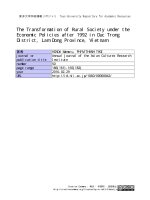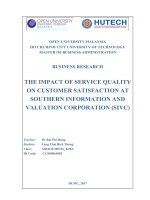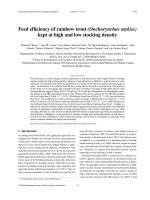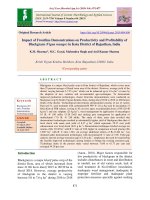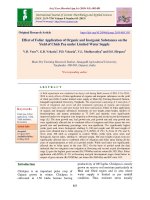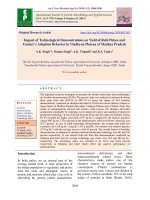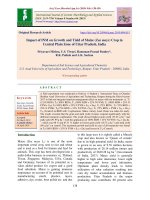Impact of success cases under RKVY scheme at Krishi Vigyan Kendra, Rudrur, Nizamabad district, India
Bạn đang xem bản rút gọn của tài liệu. Xem và tải ngay bản đầy đủ của tài liệu tại đây (1.73 MB, 9 trang )
Int.J.Curr.Microbiol.App.Sci (2018) 7(10): 2661-2669
International Journal of Current Microbiology and Applied Sciences
ISSN: 2319-7706 Volume 7 Number 10 (2018)
Journal homepage:
Review Article
/>
Impact of Success Cases under RKVY Scheme at Krishi Vigyan Kendra,
Rudrur, Nizamabad District, India
C. Padma Veni1, Bandaru Venkata Rajkumar2, P. Vijay Kumar3, M. Bhavya Manjari4
and B. Kranthi Kumar5*
1
(Agril. Extension) & Programme Coordinator, 2(Horticulture), 3(Plant Protection), 4(Home
Science), 5(Crop Production), KVK, Rudrur, Telangana, India
*Corresponding author
ABSTRACT
Keywords
Rashtriya Krishi
Vikas Yojana
(RKVY), Annual
growth in
agriculture
Article Info
Accepted:
20 September 2018
Available Online:
10 October 2018
Rashtriya Krishi Vikas Yojana (RKVY) is a State Plan Scheme of
Additional Central Assistance launched during August, 2007 as a part of
the 11th Five year plan by the Government of India to achieve 4 % annual
growth in agriculture through development of agriculture and allied sectors.
Krishi Vigyan Kendra, Rudrur was allocated fund Rs.22,00,000/- under
RKVY during 2014-15 for organising Field Testing and Popularizing
Integrated Farming System Approach for the sustainable livelihoods where
Vanaraja Birds were distributed to 37 beneficiaries. Smt. Shameem, SHG
member of KVK adopted village successfully implemented backyard
poultry and started and rose to the occasion to earn Rs. 2000/- per month by
2016-17 after consuming by the family. KVK motivated the farmers on the
use of Raised bed planter, Sugarcane Ridger, Paddy straw Baler to promote
Farm mechanization in their fields by use of Success stories documented.
The farmers after attending demonstrations at KVK, implemented Raised
Bed Planting of Maize, Earthing operations in Sugarcane and Bailing of
paddy straw with Paddy Straw Baler.
Introduction
Rashtriya Krishi Vikas Yojana (RKVY) is a
State Plan Scheme of Additional Central
Assistance launched during August, 2007 as a
part of the 11th Five year plan by the
Government of India to achieve 4 % annual
growth in agriculture through development of
agriculture and allied sectors. Under this
scheme KVK, Rudrur distributed Vanaraja
2661
Int.J.Curr.Microbiol.App.Sci (2018) 7(10): 2661-2669
birds for the promotion of backyard poultry
during 2012-13, promoted Extension services
like skill development & trained the farming
community and organized study tours of
farmers to places of interest to them,
especially to Research Institutions etc. and
promoted farm mechanization by conducting a
series of demonstrations on the farm
implements received during 2014-15 viz. 4WD
22 hp Mini tractor with attachments (Tractor
mounted Boom sprayer, Cultivator, Sugarcane
Ridger, Seed cum ferti drill, Reversible mould
board plough, Rotovator, Leveling blade,
Tractor trailer, Power tiller, Power tiller
trolley), Multipurpose power weeder, Tractor
operated multi crop thresher, Paddy straw
baler, Raised Bed Planter, Tractor drawn 11
tyre rigid cultivator, Front mounted leveling
blade, Sprinkler system, High pressure
knapsack sprayer (Taiwan), Paddy drum
seeder and Paddy power weeder.
distributed Vanaraja birds to 37 beneficiaries
@11 hens and 1 cock per beneficiary brought
from the Project Directorate on Poultry,
Rajendranagar, Hyderabad along with
organizing training programmes on Poultry
feed and poultry manure for cultivation of
field crops, orchards and vegetables. All 37
beneficiaries got benefited and Smt. Shameem
as one among them with five family members
says, the birds with good weight lay egg for
eight months from the age of 6 months and
daily consumption of which improves family
health and eggs for hatchery promote micro
enterprise (Rs. 10/egg). Ten families in
Jalalpur village bought eggs from Smt.
Shameem and reared vanaraja birds getting an
assured income with improved family health.
From 2012 till date she produced 30 birds
despite the problem of gulping by domestic
dogs and cats in her backyard.
Raised bed planter raised maize yields
The Impact of few success cases under RKVY
scheme is presenting below.
Backyard
livelihood
poultry
sustained
Shameem
Backyard poultry sustained livelihood of
Shameem, SHG women of Jalalpur, KVK
adopted
village,
Nizamabad
district,
Telangana state with an assured income of
Rs.27, 500 per annum. Smt. Shameem
struggled hard for family income in the
absence of even small enterprise up till 201112. With the choose of Jalalpur as a KVK
adopted village smt. Shameem has become an
interested, enthusiastic and dynamic member
of Scientific Advisory Committee (SAC)
during 2011-12 and participated in many KVK
training programmes since then.
Under RKVY project on “Field Testing and
Popularizing Integrated Farming System
Approach for the sustainable livelihoods”
during 2012-13 Krishi Vigyan Kendra, Rudrur
Maize (Zea mays) is one of the important
cereal crops in Nizamabad district grown as
rainfed kharif crop after paddy as the soils and
climate are most conducive to the crop. But
most often the crop is getting affected with
excess rains resulting low yields. To overcome
the problem and get high yield, KVK, Rudrur
conducted On Farm Testing (OFT) on
“Performance Assessment of Raised Bed
Planter in Maize” in six locations in
Hanmajipet village, Banswada mandal,
erstwhile
Nizamabad
district
(Present
Kamareddy district) during kharif, 2017.
The farmers practice of sowing the seed on
flat beds which got affected with rains
received during August and September, 2017
(173.4 and 282.3 mm, respectively) resulted in
low yield, whereas the raised beds prepared by
Raised Bed Planter helped in preventing
waterlogging allowing the soils to drain excess
water with the maintenance of good aeration,
ultimately yielding good.
2662
Int.J.Curr.Microbiol.App.Sci (2018) 7(10): 2661-2669
Details of Backyard Poultry of Smt. Shameem
1
2
3
4
5
6
7
Average body weight of female vanaraja bird at 20 weeks of age = 2150 g
Average body weight of male vanaraja bird at 20 weeks of age = 2430 g
Average body weight of female vanaraja bird at 40 weeks of age= 3540 g
Average body weight of male vanaraja bird at 40 weeks of age =4903 g
The average age at first egg laying = 180 days
The average egg production at the age of 40 weeks = 59 eggs
The annual egg production per hen = 154 numbers
Details of expenditure on backyard poultry of Smt. Shameem
S.
No
Year
1.
2012-13
2.
2016-17
Vanaraja birds
No. of Vanaraja birds
No. of eggs produced
per day
11
11
No. of Vanaraja birds
No. of eggs produced
per day
Average no. of
damaged eggs per day
Average no. of healthy
eggs per day
No. of birds sold for
meat purpose
25
25
Expenditure
incurred on
rearing
vanaraja birds
per annum
Rs. 5,500
Rs. 10,500
5
20
5
Income per annum after
taking 5 eggs daily for
family consumption
6x240 (8 months x 30
days)=1440 eggs
50 % of eggs sold
after keeping 50% for own
hatchery purpose= 720 eggs
only
720x10/-= 7200.00
15x240 (8 months x
30 days)=3600 eggs
50 % of eggs sold
after keeping 50% for own
hatchery purpose= 1800eggs
only
1800x20/-= 36000.00
5x400/-=2000.00
Profit
(Rs.)
72005500=1,700
36,000 +
200010,500=
27,500
Smt. Shameem started earning Rs. 1,700 during 2012-13 with 11 birds and rose to the occasion to earn Rs. 27,500
by 2016-17 with backyard poultry.
Table.1 Yield and Economic details of Maize (var. KNMH-4010141) by Raised Bed Planter and
Flat Bed method
Particulars
Yield (q/acre)
Gross income (Rs.)
Net Returns (Rs.)
B: C ratio
Raised bed Planter sowing
33.58
47856
33756
3.40:1
2663
Farmers practice of Flat bed method
29.00
41491
25875
2.66:1
Int.J.Curr.Microbiol.App.Sci (2018) 7(10): 2661-2669
Performance of Sugarcane Ridger in comparision to traditional method is given below
Particulars
Traditional method
Operation
Earthing up
Tractor
drawn Earthing up
Sugarcane Ridger
Spacing
90 x 30 cm
150 x 30 cm (5ft)
Cost of Cultivation
24 persons for 2 times @
Rs. 410/- per person
24 persons x 410/- x 2
times =19680/- per acre
2 hours per acre + 10
litres fuel charges
Distribution of Vanaraja birds and organizing Training programmes
Smt. Shameem with her Poultry enterprise
Vanaraja birds
Produced birds
Incubation
Eggs
Chicks
2664
Int.J.Curr.Microbiol.App.Sci (2018) 7(10): 2661-2669
2665
Int.J.Curr.Microbiol.App.Sci (2018) 7(10): 2661-2669
A series of demonstrations on Raised Bed Planter were conducted to the farmers at
KVK, Rudrur
Demonstrations
on
Raised Bed
Planter
Earthing up operation by Sugarcane Ridger
2666
Int.J.Curr.Microbiol.App.Sci (2018) 7(10): 2661-2669
Demonstration on Paddy Straw Baler to the
farmers
Farmers observing bundle of Paddy Straw Baler
The yield and economic details are depicted
in the above table.
Sugarcane
Operation
Ridger
for
Earthing
Up
Sugarcane, once a major commercial crop in
Nizamabad district with 8132 lakh ha.
(During 2011-12) now declined drastically in
its cultivable area by 2415 lakh ha due to
various reasons. (Source: Directorate of
Economics & Statistics 2015-16) Being high
labour intensive crop as one of the major
reasons for declined area, a shift is called for
towards mechanization in order to revive its
earlier vigour. Hence, the use of Sugarcane
Ridger, a tractor drawn implement for whole
earthing up operation with slight adjustment
in spacing is the need of hour. Sugarcane
Ridger
allows
intercultural
operation
especially weeding.
In comparision to traditional method of
Sugarcane cultivation with less spacing (90 X
30cm), the earthing up operation is laborious
requiring 24 labour per day for 2 days per
acre with high labour cost incurring more
total expenditure.
2667
Int.J.Curr.Microbiol.App.Sci (2018) 7(10): 2661-2669
Keeping this in view, KVK promoted a
tractor drawn Sugarcane Ridger for farm
mechanization received under Rashtriya
Krishi Vikas Yojana (RKVY) during 2014-15
through Regional Sugarcane & Rice Research
Station (RS&RRS) by which one could
operate 1 acre in a span of 2 hrs performing
all the Ridger operations in a single stretch.
Since this ridger performs weeding
simultaneously, do not require rotovator
thereby suppressing weed growth and
increasing yields by 8-10 per cent. This
implement operated with 35.0 HP tractor.
To popularize this, a series of training-cumdemonstration during Kisan Sammelan
programmes were organized at the KVK
Rudrur. Farmers convinced the performance
of the implement which shown a raise in the
yields because of well maintenance of micro
climate ensuring higher row to row distance
(150.0 x 30.0 cm) in comparision to the
spacing of 90 x 30 cm at RS&RRS
experimental plots.
Impressed with the performance in terms of
reduced cost of cultivation and higher yields
in the RS&RRS experimental plots, farmers
got motivated for the adoption of
mechanization in Sugarcane with Sugarcane
Ridger.
Baling Bails Out From Pollution
The practice of burning paddy straw after
harvesting is being commonly observed due
to high cost involved in traditional method of
in-field management. With adoption of latest
technologies where combine harvesters
replaced the traditional sickle harvesting,
huge amount of straw is being burnt away,
otherwise could contribute to the income of
farmer. Baling is one of the efficient and
environmentally safe option against burning
practice.
With a view of promoting mechanization in
cultivation, strawbaler is one of the
implements provided under RKVY scheme by
the university to KVK, Rudrur. The baler
provided was Shaktiman make and runs with
minimum of 35 HP tractor with power drawn
from PTO shaft. The baler produces round
type bales with size of 2.5 ft width and 2ft
diameter with each bale weighting
approximately 10-15 kg depending on the
amount of moisture in the straw with a
capacity of 15-18 bales per hour.
The unbaled and non-compacted paddy straw
is difficult to transport and takes huge amount
of storage space. Demonstrations conducted
during the Kisan Sammelans attracted the
attention of farmers and realized the
advantages of compaction and ability of
stalking of bales for easy transport. The straw
also fetches additional income to the farmer
and saves the expenditure on livestock feed. It
also provides rural youth an income
generating activity and simultaneously
checking the environmental pollution. These
advantages impacted many farmers to enquire
about the straw baler and few purchased also.
The activities taken up and implements used
under RKVY scheme helped the farming
community in many folds. The success stories
documented on the impact of Distribution of
Vanaraja Birds to Miss. Shameem for the
promotion of backyard poultry motivated
other women to adopt the same. Similarly the
success stories documented on the use of
Raised bed planter in maize, Sugarcane ridger
and Paddy straw baler helped in promoting
farm mechanization in Nizamabad district.
Reference
Rashtriya Krishi Vikas Yojana 2014:
Operational guidelines for XII five
year plan Department of Agriculture
2668
Int.J.Curr.Microbiol.App.Sci (2018) 7(10): 2661-2669
and
Cooperation,
Ministry
of
Agriculture, Government of India.
Sugarcane crop, Nizamabad. Directorate of
Economics and Statistics 2015-16
Annual
Progress reports Krishi Vigyan
Kendra, Rudrur 2014-15, 2015-16 and
2017-18
How to cite this article:
Padma Veni C., Bandaru Venkata Rajkumar, P. Vijay Kumar, M. Bhavya Manjari and Kranthi
Kumar, B. 2018. Impact of Success Cases under RKVY Scheme at Krishi Vigyan Kendra,
Rudrur, Nizamabad District, India. Int.J.Curr.Microbiol.App.Sci. 7(10): 2661-2669.
doi: />
2669

